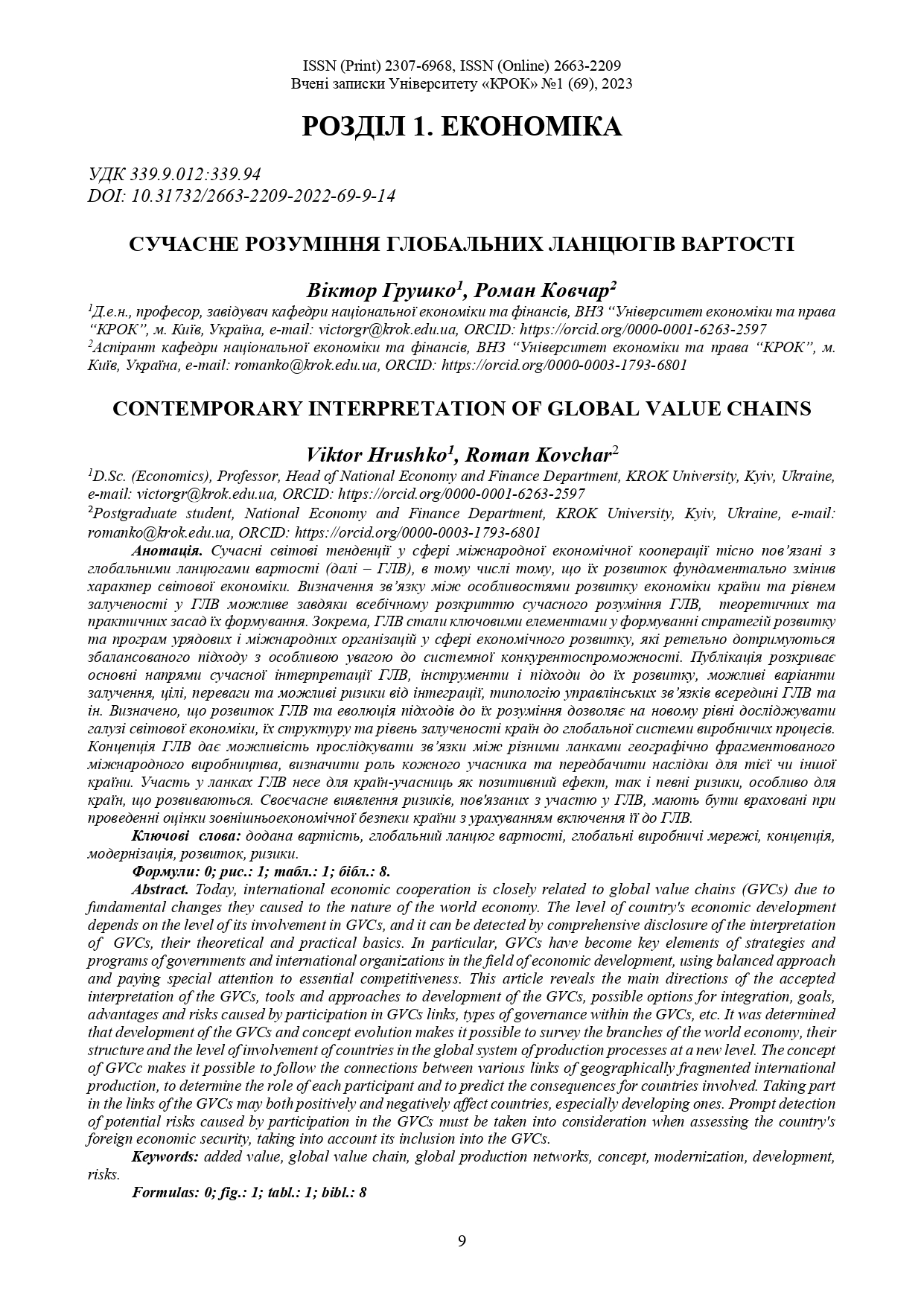CONTEMPORARY INTERPRETATION OF GLOBAL VALUE CHAINS
DOI:
https://doi.org/10.31732/2663-2209-2022-69-9-14Keywords:
added value, global value chain, global production networks, concept, modernization, development, risksAbstract
Today, international economic cooperation is closely related to global value chains (GVCs) due to fundamental changes they caused to the nature of the world economy. The level of country's economic development depends on the level of its involvement in GVCs, and it can be detected by comprehensive disclosure of the interpretation of GVCs, their theoretical and practical basics. In particular, GVCs have become key elements of strategies and programs of governments and international organizations in the field of economic development, using balanced approach and paying special attention to essential competitiveness. This article reveals the main directions of the accepted interpretation of the GVCs, tools and approaches to development of the GVCs, possible options for integration, goals, advantages and risks caused by participation in GVCs links, types of governance within the GVCs, etc. It was determined that development of the GVCs and concept evolution makes it possible to survey the branches of the world economy, their structure and the level of involvement of countries in the global system of production processes at a new level. The concept of GVCc makes it possible to follow the connections between various links of geographically fragmented international production, to determine the role of each participant and to predict the consequences for countries involved. Taking part in the links of the GVCs may both positively and negatively affect countries, especially developing ones. Prompt detection of potential risks caused by participation in the GVCs must be taken into consideration when assessing the country's foreign economic security, taking into account its inclusion into the GVCs.
Downloads
References
Дугінець Г. В. Глобальні ланцюги вартості: монографія. Дугінець Г. В., Київ, Київський національний торговельно-економічний ун-т, 2018.
Кизим М. О. Теоретичні засади розвитку глобальних ланцюгів створення вартості. М. О. Кизим, Г. В. Крамарев, О. Ю. Іванова та ін. Бізнес Інформ. 2018, № 12, с. 39-51.
Gereffi G., Risks and Opportunities of Participation in Global Value Chains, World Bank Policy Research Working Paper, April, 2014. URL: https://openknowledge.worldbank.org/handle/10986/18333
Gereffi G., Fernandez-Stark K. Global Value Chain Analysis: A Primer, Center on Globalization, Governance & Competitiveness (CGGC), Duke University Durham, 2011. URL: https://www.researchgate.net/publication/265892395_Global_Value_Chain_Analysis_A_Primer
Gereffi G., Fernandez-Stark K. Global Value Chain Analysis: A Primer, 2nd Edition, Center on Globalization, Governance & Competitiveness (CGGC), Duke University Durham, 2016. URL : https://www.researchgate.net/publication/305719326_Global_Value_Chain_Analysis_A_Primer_2nd_Edition
Gereffi G., Humphrey J., Sturgeon T. The governance of global value chains. Review of international political economy, 2005. URL: https://www.fao.org/fileadmin/user_upload/fisheries/docs/GVC_Governance.pdf
Porter M. Competitive advantage: creating and sustaining superior performance. M. Porter. New York, 1985. URL: https://www.albany.edu/~gs149266/Porter%20(1985)%20-%20chapter%201.pdf
United Nations Industrial Development Organization report on Global value chains, December 2015. URL: https://www.unido.org/sites/default/files/2016-03/gvc_report_final_0.pdf

Downloads
Published
How to Cite
Issue
Section
License

This work is licensed under a Creative Commons Attribution-NonCommercial 4.0 International License.

